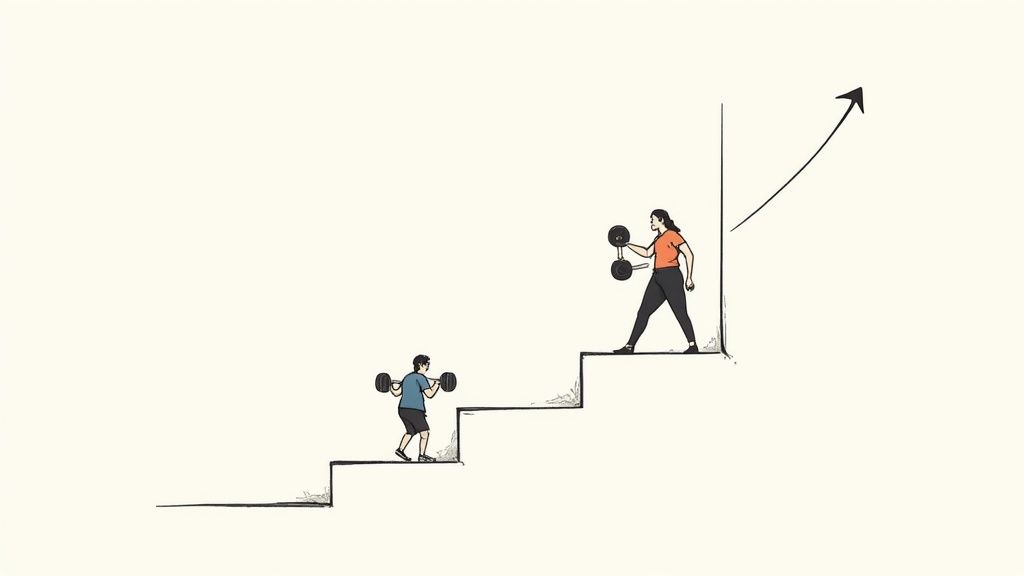A 2 day split workout is a simple yet powerful way to build strength and muscle on a busy schedule. The idea is straightforward: you divide your exercises into two separate workouts—typically an upper body day and a lower body day—and perform them on non-consecutive days each week. This approach gives you the perfect balance of intense training and essential recovery, helping you get incredible results without living in the gym.
Why a 2 Day Split Workout is So Effective

If you believe that getting fit requires spending five or six days a week working out, it's time to rethink your strategy. You can achieve fantastic results by training smarter, not just harder. A 2 day split workout is built on the principle of quality over quantity. Instead of spreading your energy thin across too many sessions, you pour all your effort into two focused, high-impact workouts.
This method is incredibly effective because it perfectly balances the two most critical components of muscle growth: stimulus and recovery.
The Power of Focused Training
When you split your routine into an upper-body day and a lower-body day, you can give each muscle group the undivided attention it deserves. This focus allows you to perform each exercise with more intensity and volume—the primary drivers for building real strength and muscle. Instead of rushing through a few exercises for every body part in a single full-body workout, you get to thoroughly work the target muscles. This sends a much stronger signal to your body to adapt and grow, which is the magic of a 2 day split workout.
Maximizing Recovery for Better Growth
Here’s a secret many people miss: muscle isn't built while you're lifting; it's built when you're resting. The ample recovery time in a 2 day split workout is its biggest advantage. With several days off between hitting the same muscle groups, they have the time they need to repair, rebuild, and come back stronger.
This extended recovery is crucial for preventing overtraining, which can stall your progress and lead to injury. It also ensures you feel fresh and ready to give your all in your next workout. This balance is what creates consistent, long-term gains without the burnout that plagues more demanding schedules.
The biggest barrier to fitness results isn't the workout plan—it's consistency. A two-day schedule is realistic, manageable, and easy to stick with, making it far more likely you'll achieve your goals.
Scientific reviews back this up, confirming that training a muscle group twice a week is fantastic for strength gains. Plus, people are much more likely to stick with it. Adherence rates for 2-day splits often top 50% after six months, while more demanding 4-5 day routines see dropout rates soar, with only 25–30% of people remaining. You can dig into more insights about workout frequency on HevyApp.com.
This proves one thing: a manageable 2 day split workout almost always beats a "perfect" plan that you can't stick to.
The Bare Fitness 2 Day Split Workout Routine

Alright, let's get to the good stuff. This is your straightforward, no-nonsense plan designed for maximum results with minimal equipment. I’ve built this 2-day split workout around compound movements—exercises that work multiple muscle groups at once—because it’s the most efficient way to get strong without spending hours working out.
The plan is simple: one day for your upper body and one for your lower body and core. Let's dive in.
What You'll Need
At Bare Fitness, we believe in keeping things simple. You don’t need a fancy gym membership to get a great workout. All you need is one of the following:
- A pair of adjustable dumbbells: These are a fantastic investment for home workouts, allowing you to increase the weight as you get stronger.
- A set of resistance bands: A versatile and budget-friendly option with different tension levels.
A sturdy chair or a bench can also be helpful for exercises like rows, but it’s definitely not a deal-breaker if you don't have one.
Your Weekly Workout Plan
Here is your complete weekly schedule. Your goal is to focus on your form and feel the right muscles working. Don't just go through the motions—make every rep count.
This 2-day split workout is a balanced program designed for real-world results. A well-structured plan like this provides 15–18 sets per muscle group each week, hitting the sweet spot for muscle growth. I've seen it time and again: clients who stick to a 2-day split workout for at least three months often report a 12–15% increase in their one-rep max strength. If you want to dive deeper into the science of effective workout splits, Built With Science has some great resources.
Key Takeaway: Consistency is your most powerful tool. Aim to complete both workouts each week, focusing on good form and gradually challenging yourself. This simple, effective routine is all you need to build a stronger, healthier body.
Scheduling Your Workouts for Maximum Growth

The real magic of a 2 day split workout doesn't happen when you’re exercising—it happens on your rest days. Your schedule is the secret ingredient that turns all that hard work into real strength and muscle. Think of your workout as the signal that tells your muscles it's time to grow. Recovery is when your body actually does the rebuilding. If you don't leave enough time between sessions, you're just sending signals without giving your body a chance to get the job done.
Finding Your Perfect Weekly Rhythm
The cornerstone of a great schedule is giving yourself at least one full rest day between your upper and lower body workouts. This isn't just a suggestion; it’s essential for proper muscle repair and keeps you feeling energized instead of constantly worn out.
Here are a few popular options that work incredibly well for busy lives:
- The Classic: Monday (Upper) & Thursday (Lower)
- The Weekend Warrior: Saturday (Upper) & Tuesday (Lower)
- The Mid-Week Split: Tuesday (Upper) & Friday (Lower)
These are just starting points. The best 2 day split workout schedule is the one that actually fits your life. Whether you train on a Wednesday and Saturday or a Sunday and Wednesday, consistency is what truly matters.
Making the Most of Your Days Off
Rest days don't mean you have to be glued to the couch. In fact, getting in some active recovery can speed up muscle repair and reduce post-workout soreness. Active recovery is simply light, low-impact movement that boosts blood flow without putting more strain on your muscles.
Try one of these simple options:
- A brisk 20-30 minute walk
- A gentle stretching or light yoga session
- A casual bike ride
These activities help shuttle nutrients to your recovering muscles, which helps you bounce back faster for your next workout. It's a small tweak that can make a huge difference in your results from the 2 day split workout.
Your body gives you feedback every single day. A little muscle soreness is the mark of a good workout, but feeling completely exhausted or achy is a clear sign you need more rest. Learning to listen to those signals is one of the most valuable fitness skills you can ever build.
At the end of the day, your schedule isn't set in stone. If you feel wiped out one week, it's perfectly fine—and smart—to take an extra rest day. The flexibility of this plan is one of its biggest perks. Let your routine work for you, not the other way around.
How to Progress and Keep Getting Stronger

Starting a new routine is a huge win, but the real magic happens weeks and months down the line when the initial excitement fades and progress might slow down. This is where many people get frustrated and quit, but stalling is completely avoidable if you have a plan. The secret is a core principle of strength training called progressive overload.
Put simply, this means you have to consistently challenge your muscles a little bit more over time. If you keep lifting the same weight for the same reps, your body adapts and has no reason to get any stronger. Progressive overload is the engine that drives long-term results in any 2 day split workout.
Mastering Progressive Overload
So, how do you do this? It's not about trying to add 20 pounds to your squat every week—that's a recipe for injury. Progress is a slow and steady process, and there are a few simple ways to increase the challenge.
Here are the most practical methods to use:
- Add More Reps: If you did 8 push-ups last week, your goal this week is 9 or 10 with good form. Once you can comfortably hit the top of your target rep range (e.g., 12 reps), you're ready to make another change.
- Add More Weight: The most obvious method. If you nailed 10 goblet squats with a 20 lb dumbbell, try a 25 lb one next time. Even a small jump in weight forces your muscles to adapt.
- Increase Sets: Hitting your 3 sets of 12 lunges without a problem? Great. Next week, try adding a fourth set. This increases your total workout volume, which is a fantastic way to spur new growth.
- Decrease Rest Time: If you normally take 90 seconds between sets, try resting for only 75. This makes the workout more challenging and forces your muscles to recover more efficiently.
The key is to focus on one method at a time. This methodical approach ensures your 2 day split workout keeps you moving forward safely.
Track Your Work to See Your Growth
You can't progress what you don't measure. One of the best things you can do for your fitness journey is to keep a simple workout log. It turns guesswork into a clear plan and keeps you accountable. You don't need anything fancy—a cheap notebook or the notes app on your phone is perfect.
Progress Log Example:Workout: Upper Body - Week 3Dumbbell Row:
- Set 1: 25 lbs x 10 reps
- Set 2: 25 lbs x 9 reps
- Set 3: 25 lbs x 8 repsGoal for Week 4: Beat these numbers! Aim for 10, 10, and 9 reps.
Jotting down your numbers shifts your mindset from just "working out" to "training." Every session now has a purpose: to be just a little bit better than last time. It’s the single most reliable way to make sure your 2 day split workout keeps working for you month after month.
Common Mistakes to Avoid with a 2 Day Split
Even the best workout plan can fall short if you fall into a few common traps. A 2 day split workout is a powerful tool, but sidestepping these frequent mistakes is key to making sure your hard work pays off. Let's make sure you're working smarter.
Mistake 1: Ego Lifting
The most common pitfall is "ego lifting"—hoisting the heaviest weight you can possibly move, often at the expense of proper technique. Sure, it might feel impressive, but bad form is a fast track to injury. Worse, it means you aren't even working the muscles you're trying to train. The real goal isn't just moving a weight from point A to point B; it's feeling a solid, controlled contraction in the target muscle.
Mistake 2: Skipping the Warm-Up and Cool-Down
Another all-too-common shortcut is treating your warm-ups and cool-downs as optional extras. They are just as vital as the main lifts themselves.
- The Warm-Up: Think of this as priming your body for action. A good warm-up gets blood flowing, lubricates your joints, and wakes up your nervous system. Just five minutes of dynamic stretching and some light cardio can make a huge difference in your performance and safety.
- The Cool-Down: This is your transition back to daily life. A cool-down helps your body gradually return to its resting state. A little gentle stretching can improve flexibility and may even reduce next-day muscle soreness.
Mistake 3: Ignoring Nutrition
Finally, you can't forget that results are built outside of your workout sessions. One of the biggest mistakes is believing that two workouts a week can magically erase a poor diet. Your body needs high-quality fuel to perform, recover, and grow. Skimping on nutrition, especially protein, is like trying to build a house without bricks. Protein is essential for muscle repair; without enough of it, your muscles simply can't rebuild stronger.
Think of it this way: your workout is the spark, but nutrition is the fuel. You can't build a strong body with just one. Your progress from the 2 day split workout depends just as much on what’s on your plate as it does on the weights you lift.
By steering clear of these common mistakes, you set the stage for real, lasting success and make every single rep count.
Frequently Asked Questions About the 2-Day Split
Jumping into any new routine will bring up some questions. That's a great sign—it means you're taking this seriously. Let's answer some of the most common questions about the 2-day split workout so you can start with complete confidence.
"Can I really build muscle working out just twice a week?"
Absolutely. The idea that you have to live in the gym to see results is one of the biggest fitness myths out there. Muscle growth comes down to two things: giving your muscles a strong reason to grow (stimulus) and then giving them time to actually do it (recovery). A well-designed 2-day split nails both. You hit your muscles hard and then get plenty of rest for your body to repair and rebuild stronger.
"What equipment do I actually need?"
We built this plan around the Bare Fitness philosophy: keep it simple and effective. You don't need a full home gym.
- A pair of adjustable dumbbells is the gold standard for home workouts.
- A set of good resistance bands will also do the trick for nearly every exercise.
- A solid chair or bench is helpful for support but is not essential.
You can get incredible results with just the basics.
"Is an upper/lower split better than two full-body days?"
For a two-day schedule, the upper/lower split is fantastic. It lets you pour all your energy into one half of your body for an entire workout, allowing for more intensity and volume for each muscle group. While two full-body days can also work, you often end up spreading yourself too thin. The upper/lower structure is designed for maximum bang for your buck on a 2-day split workout schedule.
The best workout on the planet is the one you actually stick with. Stop chasing perfection. Just focus on getting those two sessions done each week, and trust that the results will come.
"What if I miss a workout?"
Life happens! Missing a workout is not the end of the world. The flexibility of a 2-day split workout is one of its biggest strengths. If you miss a day, just do the workout on the next day you have free and adjust your schedule from there. Or, you can just skip it and jump right back on track with your next scheduled session. One missed workout won't undo your progress. Consistency over the long haul is what truly matters.
Ready to build a stronger, healthier you with a routine that actually fits your life? At Bare Fitness, we give you the plans and tools to get it done with minimal gear and maximum impact. Check out our other guides and start your journey today at https://barefitness.com.



















